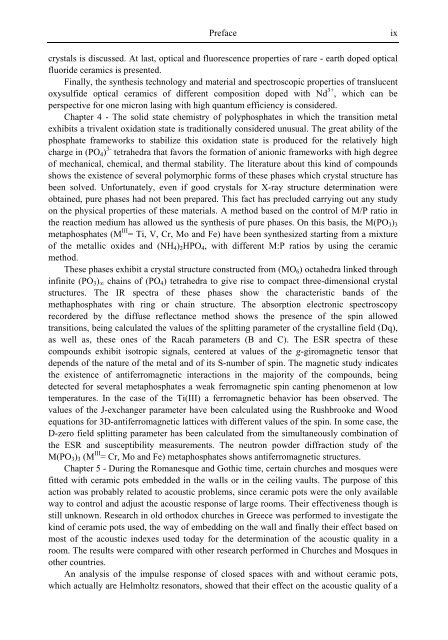Developments in Ceramic Materials Research
Developments in Ceramic Materials Research
Developments in Ceramic Materials Research
Create successful ePaper yourself
Turn your PDF publications into a flip-book with our unique Google optimized e-Paper software.
Preface ix<br />
crystals is discussed. At last, optical and fluorescence properties of rare - earth doped optical<br />
fluoride ceramics is presented.<br />
F<strong>in</strong>ally, the synthesis technology and material and spectroscopic properties of translucent<br />
oxysulfide optical ceramics of different composition doped with Nd 3+ , which can be<br />
perspective for one micron las<strong>in</strong>g with high quantum efficiency is considered.<br />
Chapter 4 - The solid state chemistry of polyphosphates <strong>in</strong> which the transition metal<br />
exhibits a trivalent oxidation state is traditionally considered unusual. The great ability of the<br />
phosphate frameworks to stabilize this oxidation state is produced for the relatively high<br />
charge <strong>in</strong> (PO4) 3- tetrahedra that favors the formation of anionic frameworks with high degree<br />
of mechanical, chemical, and thermal stability. The literature about this k<strong>in</strong>d of compounds<br />
shows the existence of several polymorphic forms of these phases which crystal structure has<br />
been solved. Unfortunately, even if good crystals for X-ray structure determ<strong>in</strong>ation were<br />
obta<strong>in</strong>ed, pure phases had not been prepared. This fact has precluded carry<strong>in</strong>g out any study<br />
on the physical properties of these materials. A method based on the control of M/P ratio <strong>in</strong><br />
the reaction medium has allowed us the synthesis of pure phases. On this basis, the M(PO3)3<br />
metaphosphates (M III = Ti, V, Cr, Mo and Fe) have been synthesized start<strong>in</strong>g from a mixture<br />
of the metallic oxides and (NH4)2HPO4, with different M:P ratios by us<strong>in</strong>g the ceramic<br />
method.<br />
These phases exhibit a crystal structure constructed from (MO6) octahedra l<strong>in</strong>ked through<br />
<strong>in</strong>f<strong>in</strong>ite (PO3)∞ cha<strong>in</strong>s of (PO4) tetrahedra to give rise to compact three-dimensional crystal<br />
structures. The IR spectra of these phases show the characteristic bands of the<br />
methaphosphates with r<strong>in</strong>g or cha<strong>in</strong> structure. The absorption electronic spectroscopy<br />
recordered by the diffuse reflectance method shows the presence of the sp<strong>in</strong> allowed<br />
transitions, be<strong>in</strong>g calculated the values of the splitt<strong>in</strong>g parameter of the crystall<strong>in</strong>e field (Dq),<br />
as well as, these ones of the Racah parameters (B and C). The ESR spectra of these<br />
compounds exhibit isotropic signals, centered at values of the g-giromagnetic tensor that<br />
depends of the nature of the metal and of its S-number of sp<strong>in</strong>. The magnetic study <strong>in</strong>dicates<br />
the existence of antiferromagnetic <strong>in</strong>teractions <strong>in</strong> the majority of the compounds, be<strong>in</strong>g<br />
detected for several metaphosphates a weak ferromagnetic sp<strong>in</strong> cant<strong>in</strong>g phenomenon at low<br />
temperatures. In the case of the Ti(III) a ferromagnetic behavior has been observed. The<br />
values of the J-exchanger parameter have been calculated us<strong>in</strong>g the Rushbrooke and Wood<br />
equations for 3D-antiferromagnetic lattices with different values of the sp<strong>in</strong>. In some case, the<br />
D-zero field splitt<strong>in</strong>g parameter has been calculated from the simultaneously comb<strong>in</strong>ation of<br />
the ESR and susceptibility measurements. The neutron powder diffraction study of the<br />
M(PO3)3 (M III = Cr, Mo and Fe) metaphosphates shows antiferromagnetic structures.<br />
Chapter 5 - Dur<strong>in</strong>g the Romanesque and Gothic time, certa<strong>in</strong> churches and mosques were<br />
fitted with ceramic pots embedded <strong>in</strong> the walls or <strong>in</strong> the ceil<strong>in</strong>g vaults. The purpose of this<br />
action was probably related to acoustic problems, s<strong>in</strong>ce ceramic pots were the only available<br />
way to control and adjust the acoustic response of large rooms. Their effectiveness though is<br />
still unknown. <strong>Research</strong> <strong>in</strong> old orthodox churches <strong>in</strong> Greece was performed to <strong>in</strong>vestigate the<br />
k<strong>in</strong>d of ceramic pots used, the way of embedd<strong>in</strong>g on the wall and f<strong>in</strong>ally their effect based on<br />
most of the acoustic <strong>in</strong>dexes used today for the determ<strong>in</strong>ation of the acoustic quality <strong>in</strong> a<br />
room. The results were compared with other research performed <strong>in</strong> Churches and Mosques <strong>in</strong><br />
other countries.<br />
An analysis of the impulse response of closed spaces with and without ceramic pots,<br />
which actually are Helmholtz resonators, showed that their effect on the acoustic quality of a
















